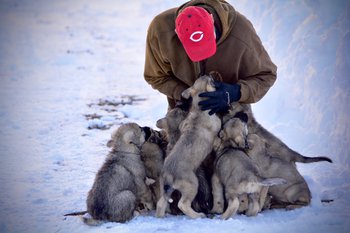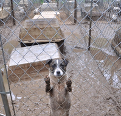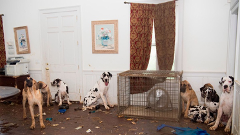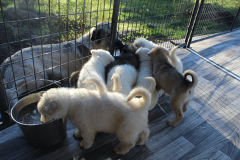Is the Dire Wolf Project a puppy mill?
By Jennifer Stoeckl, MAT - Dire Wolf Project CEO, Jan. 2, 2023
From time to time, the Dire Wolf Project is targeted as a puppy mill. Usually, the name callers also claim we are backyard breeders. These nasty terms are thrown around so often just like “racism”, “bigot” and “homophobic” that they have lost all real meaning. Now, any dog breeder is deemed a puppy mill or backyard breeder whenever the breeder does something someone else doesn’t like.
So, instead of shouting nasty slurs in an emotional rage from behind a computer screen, let’s look into these allegations and see if we can shed some light on the subject.
Are Dire Wolf Project breeders puppy mills who need to be shut down because our dogs are suffering from lack of adequate housing, hygiene and veterinary intervention?
Let’s briefly discuss the term, “puppy mill” so that you can make an informed decision for yourself. (We will look into the term “backyard breeder” at another time.)
In our current topsy-turvy world, it is important to be on the same page with our understanding of the terms used. There is no point in arguing about anything if we don’t agree on the definition of what is being claimed.
So, what are puppy mills?
While no standardized legal definition currently exists, the first legal definition was established by Avenson v. Zegart in 1984. It described a puppy mill as, “a dog breeding operation in which the health of the mill’s dogs is disregarded to maintain a low overhead and maximize profits.”
According to the Humane Society of the United States (HSUS), “puppy mills are inhumane high-volume dog breeding facilities that churn out puppies for profit, ignoring the needs of the pups and their mothers. Dogs from puppy mills are often sick and unsocialized. Puppy mills commonly sell through internet sales, online classified ads, flea markets and pet stores.”
The HSUS further breaks down the definition into the following:
- emphasis on quantity over quality
- indiscriminate breeding
- continuous confinement
- lack of human contact and environmental enrichment
- poor husbandry
- minimal to no veterinary care
According to the ASPCA, “The commercial puppy industry keeps dogs captive in cruel conditions just so they can keep making puppies.”
According to Wikipedia’s puppy mill page, “A puppy mill, also known as a puppy farm, is a commercial dog breeding facility characterized by quick breeding and poor conditions.”
The first thing to notice is that some of the definitions include the term “commercial dog breeding facility”.
This is a very specific legal term.
Many people do not understand that “commercial” has a standardized legal definition and is formally defined by law in the United States.
So, in order to establish a specific definition for a puppy mill that everyone can agree upon, we first need to know if this term should be included.
A commercial dog breeding facility is a breeding operation that sells dogs “wholesale”. In other words, commercial breeders sell dogs to other companies who then sell them to other companies or the final customer. Pet stores, animal testing labs and auction houses are three examples.
The United States Department of Agriculture (USDA) oversees regulations pertaining to the commercial dog industry. These regulations are similar to those in the livestock industry.
All dog breeding operations that sell dogs wholesale are now required by law to register their facility with the USDA, although many of them do not.
The Dire Wolf Project is NOT a commercial dog breeding facility.
We NEVER sell dogs wholesale to other companies.
We sell dogs to the final owner only.
All of our puppies/dogs are inspected personally by the new family before they take possession.
Furthermore, each owner has five business days after acquiring their new dog to return it for any reason whatsoever for a full refund of the purchase price, minus the nonrefundable deposit.
Instead, Dire Wolf Project breeders are “direct sales” dog breeders.
This is a completely different category according to law.
We are not obligated to register our breeding facility with the USDA and are not under their jurisdiction. Instead, we follow the laws set out by the states in which we reside.
So, in order to claim the Dire Wolf Project is a puppy mill, haters should not include the term “commercial dog breeding facility” or “commercial breeder”.
Let’s move on.
Do Dire Wolf Project breeders emphasize quantity over quality?
Here’s a gruesome fact for you.
One Michigan Amish puppy mill owner reportedly sold 1,293 puppies in one year grossing about $290,000 that year according to the USDA. ($224/puppy)
According to data collected by the HSUS, around 3,000 licensed commercial dog breeding facilities are regulated by the USDA throughout the United States. Statistics show that these commercial dog breeding facilities sell 1,307,407 to 2,040,000 puppies a year.
That’s an average of 436 to 680 puppies born each year by every single USDA regulated commercial dog breeding facility. (NOTE: Those are only the registered ones.)
In stark contrast, 47 American Dirus puppies were born in 2022 grossing about $140,000.
The highest number of puppies born in a single year from both Schwarz Kennels and Vallecito Kennels was 81 in 2017.
We feed premium, high quality, no grain Taste of the Wild High Prairie dog food ($57/28lbs). We supplement our dog food with Tylee’s freeze-dried beef or chicken ($35.73/18 oz).
We spend around $1800/month on dog food alone. (~$21,600/year)
How much do you think that Amish farmer pays for his dog food?
Do you think he buys a premium, high quality, no grain variety?
In 2021, we spent over $21,000 on dog kennel supplies and just under $12,000 in veterinarian expenses.
Last year, in order to deliver your puppy right to your front door, we spent around $25,000 in gas and other travel expenses.
You do the math.
Do Dire Wolf Project breeders breed dogs indiscriminately?
Again, let’s first define what indiscriminate means?
Dictionary.com defines the term in this way, “Done at random or without careful judgement.”
Well, this one’s easy.
Here is an example of the graphs created to help Dire Wolf Project breeders decide breeding decisions. (It’s not the most updated version, just an example I had on this computer)

If that wasn’t enough, I wrote a 387-page reference book defining in precise detail the breeding structure behind the Dire Wolf Project.
How careful do you think our breeding judgement is?
Do Dire Wolf Project breeders leave their dogs in continuous confinement?
You need to do your own research with this one. If you can’t click on the Facebook link where we house all of the pictures of our dogs going back to 2012 or more, then, I can’t help you.
https://www.facebook.com/direwolfdogs/photos/?ref=page_internal
Do Dire Wolf Project breeders neglect to give their dogs human interaction and environmental enrichment?
Again, I refer you to the above link. See the pictures of our dogs over the years. Watch the videos of us and our dogs. Do your own research.
Do Dire Wolf Project breeders maintain poor animal husbandry?
You would only ask this question of a Dire Wolf Project breeder if you couldn’t tell the difference between this…

And this…

But my breeder said her dogs were raised in her home…

Compared to this…

I don’t care who you are. Maintaining a clean environment for more than five giant dogs is quite a chore. If you sit comfortably in your home with two or three dogs, especially if they are of the tiny variety, you have no clue what it takes to clean up after 15 to 20 giant dogs. Hours of work each and every day go into cleaning and maintaining an adequate home space for our dogs. Not to mention the long-term goals always striving to improve the facilities in the future for the comfort of the animals that reside here.
Are some days tough.
Yep.
You betcha.
That’s reality.
We don’t live in fantasy land.
Our dogs don’t eat pink tulips filled with sugar and the water isn’t a flowing river of chocolate.
The nearby hills aren’t overflowing with milk and honey, either.
People who live in reality understand that the cute baby deer with its adorable white spots may have twenty embedded ticks and probably harbors lung worms.
Reality means that toenails might not get clipped and teeth might have some tarter on them.
The truth is dogs stick their noses everywhere potentially breathing in disease. They relish eating poop of all kinds and rolling in dead rotting animal carcasses.
Parasites are a constant issue living in harmony with nature’s abundant forest life.
But, even when they are confined to their kennel space, sometimes dogs defecate in their food bowl or put muddy paws in their water bucket.
If the truth of a dog breeding life makes you run for the hills in horror to complain to your local humane society at the sick conditions you think our dogs exist in, then you live in an alternate reality where sunbeams shoot out of your fingertips. You don’t understand a dog’s true nature or really have a grasp on the real world we all live in.
Do Dire Wolf Project breeders breed for profit?
If you mean do Dire Wolf Project breeders live a life of luxury while the dogs live in squalor. Then, no.
But, if you mean do we breed dogs in order to feed our families, pay for the energy we use, have enough to make life a little better each year, then yes. We make a small profit.
In 2021, we made just around $21,000 between the two of us. Washington state considers that poverty level. We are allowed to take free state health care because of it.
When someone claims that dog breeders who breed for profit are puppy mills, they are again thinking of life in a foggy haze of unreality.
Even non-profit organizations, such as dog rescues, animal shelters, and humane societies make enough money to pay their employees. They profit enough to pay the salaries of all the humane society workers.
According to salary.com, “The average Animal Shelter Worker salary in California is $43,249 as of November 23, 2022, but the range typically falls between $41,661 and $48,187.”
Huh. Isn’t that something?
One animal shelter worker makes double what Jay and I make in a year.
Jay and I most likely live more meagerly than most anyone else breeding or rehoming dogs. If they live in a house with hot running water, it’s already a more luxurious life than we lead.
But, that’s beside the point.
Making a profit should be every breeder’s goal.
Yep. I said it.
You can quote me.
Creating a well-bred, healthy, long-lived furry companion that people want should be the goal.
Because people vote with their pocketbooks, a great breeder, who takes the utmost care to produce only the best, should be rewarded.
It would be insane to think otherwise.
NO ONE would do it.
What incentive would there be to strive for perfection if the reward wasn’t going to be a way to pay for some good things in life?
Anyone who vilifies a breeder for “making a profit” doesn’t appreciate the art and science of producing healthy, long-lived dogs.
So, take a hike.
Please, get a shelter dog and pay their employee salaries.
I won’t get into shelter dog lies in this email, but just know this… getting a dog from the shelter helps dog traffickers and rewards the sick practice of abandoning and stealing dogs.
None of my dogs enter a shelter because Jay and I will travel to the ends of the earth to bring back any dog in need that comes from us.
We wholeheartedly believe ever breeder should do the same.
We would like to send you a free gift for spending some time with us at the Dire Wolf Project.
10 Ways to Alter Your Dog's Diet for Immediate Health Results
Jennifer Stoeckl is the co-founder of the Dire Wolf Project, founder of the DireWolf Guardians American Dirus Dog Training Program, and owner/operator of DireWolf Dogs of Vallecito. She lives in the beautiful inland northwest among the Ponderosa pine forests with her pack of American Dirus dogs.